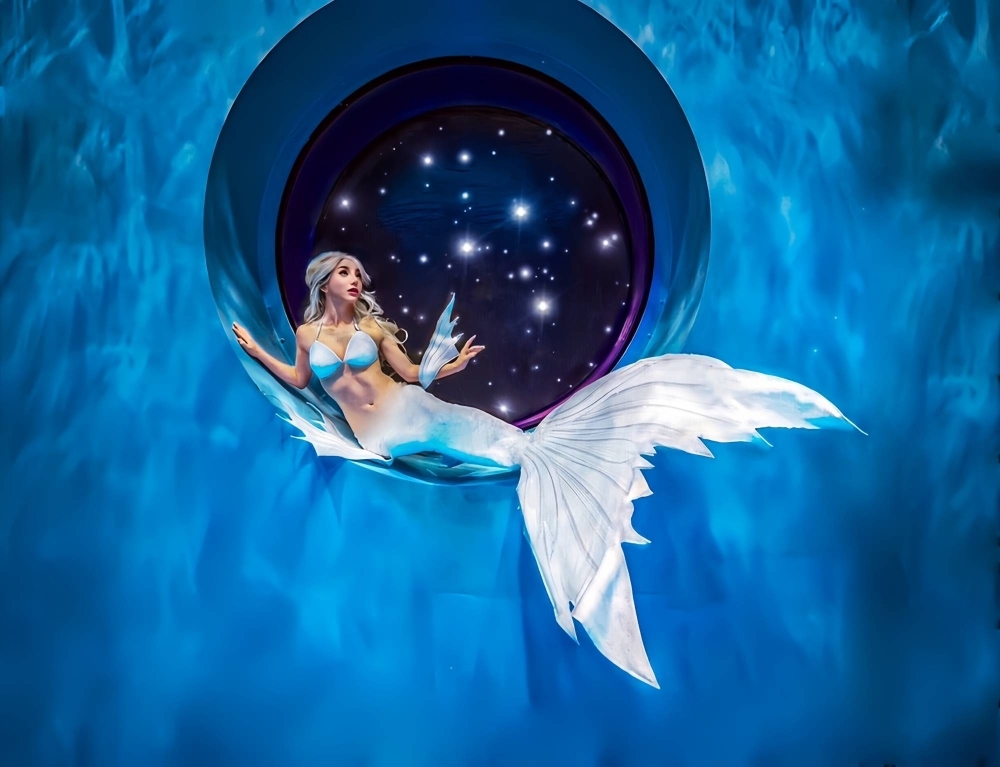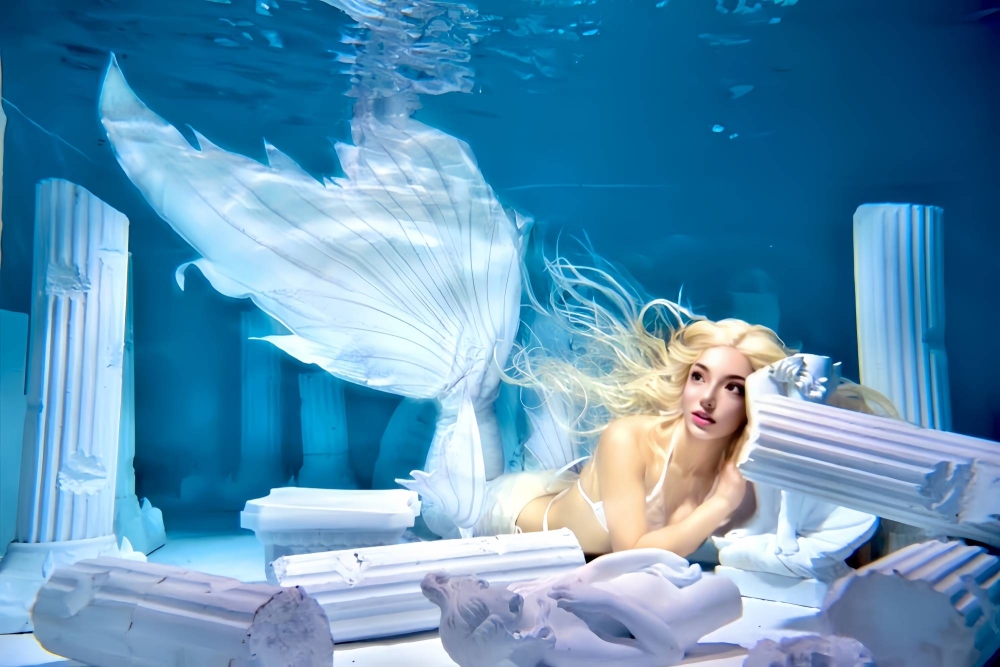Mermaids are having a moment.
Disney’s live-action remake of 1989’s “The Little Mermaid” has made a splash with audiences worldwide, but that doesn’t mean mermaids are only the stuff of fairytales: Earlier this spring, Netflix released “MerPeople,” a four-part documentary that investigates the fast-growing world of professional mermaiding.
In an industry now said to be worth around $500 million (about ¥71 billion) by some estimates, professional mermaids pull on custom-made tails to perform at aquariums, corporate events and children’s parties, coupled with strong online presences as influencers. There are also legions of mermaiding advocates who pursue the lifestyle primarily as a hobby, adopting a mermaid name (or “mersona”) and coming together in “pods” with other members of their community for meet-ups and photo shoots.
Modern mermaiding has its roots in the water ballets and underwater shows of 1940s and ’50s America, as made famous by U.S. swimming champion-turned-movie star Esther Williams. The first freelance professional mermaids began appearing in the early 2000s, with the rise of social media helping them to win audiences. Today, mermaid swim classes and coaching courses can be found in many countries. The Professional Association of Diving Instructors (PADI), primarily known as a scuba diving membership and training organization, has licensed coaches around the globe after launching its mermaid-focused program several years ago.
While mermaiding is still a niche activity in Japan, it is possible to slip on a tail and dive in.
Makoto Endo is one of Japan’s mermaid swimming pioneers. The president of aquatic activity guide company Oceanz Inc. on the island of Amami Oshima, Kagoshima Prefecture, Endo developed a love of free-diving during his travels around the world before becoming a trained mermaid swim instructor in the Philippines.
“I came across mermaiding in 2016, but at the time it wasn’t recognized beyond the realm of cosplay here in Japan,” Endo says. “We now offer a wide range of mermaid programs, from ocean swim experiences to mermaid instructor training courses. Mermaiding is generally done in a pool in Japan, but we specialize in giving participants a deeper sense of the beauty of the ocean and their connection to nature.”
Mermaid swimming is adapted from freediving, where swimmers hold their breath underwater. Using a monofin, participants learn from professional divers how to move, like a dolphin, by kicking from the waist.
At Oceanz, customers can start with a mermaid swim lesson and photo session from ¥14,300, then move up to become a licensed “aquarium model mermaid” (¥38,500) or take a two-day course to earn an “ocean mermaid” license (¥55,000).
Those with necessary qualifications and experience can take a four-day course (¥123,200) to become a certified mermaid instructor (or nine days at ¥237,600 for novices).
Apart from the aesthetic appeal of mermaiding, many in the international mermaiding community use their interest as a platform for environmental advocacy, such as participating in local clean-up projects and water conservation education. Even governments are seeing the potential of mermaids — last year, New Zealand’s national tourism agency announced a partnership with PADI to promote mermaiding as a way to highlight marine conservation.
Diving into diversity
Japan’s own mermaid mythology goes deep.
Known by the gender-neutral term ningyo (literally, “human fish”), one version was said to have shiny golden scales and the mouth of a monkey. One of the best-known ningyo folktales includes a prince, but it’s hardly a Disney-esque love story: Way back in the Yamato Period (300-710), the creature appeared before Prince Shotoku, who was revered for promoting Buddhism in Japan. Formerly a fisherman transformed as punishment for trawling in forbidden waters, the now-dying ningyo begged the prince to pardon him for his past sins.

Mermaid enthusiasts say the community embraces body positivity as one of its main tenets — a philosophy that extends to male mermen as well.
| COURTESY OF BATMAN PHOTOGRAPHER
More recently, Japan began to embrace the Western idea of the mermaid as a beautiful young woman after Danish writer Hans Christian Anderson’s beloved fairytale “The Little Mermaid” (first published in 1837) was translated into Japanese in the early 20th century. This image was further cemented when Disney released “The Little Mermaid” animated film in 1989, and the enduring appeal of Disney’s red-haired aquatic heroine has stuck ever since.
“I first encountered mermaiding in 2020, when a participant showed me her costume,” says Kurara Okuno, a Tokyo-based diving instructor and professional mermaid who models for corporate events and videos as Mermaid Lalah. “I was charmed with the idea of looking like Ariel, my favorite Disney character, and swimming like her.”
Halle Bailey, the star of the new live-action “The Little Mermaid,” is African American, a casting decision that was initially met with online vitriol from some insisting that Ariel should be white like the 1989 animated character. In direct contrast, the real-life mermaiding community embraces people of all backgrounds, ages, body types and genders.
Tokyo resident Danielle Mead — who goes by “Mermaid Melusina” for her mersona — appreciates the inclusive aspect of the community. Before moving to Japan last year with her family, Mead was active with a pod in Nashville, Tennessee.
“It doesn’t matter where you come from or what you look like — everyone is magical in the mermaid community,” says Mead, who recently started the Tokyo Mermaid Pod community on Facebook. “This is really how it has become in the United States, and I’m hoping to find out more about mermaiding here in Japan to try to incorporate that same message.”

Professional mermaid Misato Sato performs and instructs other prospective merpeople throughout the Kanto, Kansai and Okinawa regions.
| COURTESY OF NANA ABE
One of Japan’s first professional mermaids, Misato Sato (also known as “Mermaid Misa”) combines teaching and performing around the Kanto, Kansai and Okinawa regions. While Japan has skilled instructors to teach mermaid swimming, Sato says a lack of places where mermaids can don their tails and enjoy swimming is still a barrier in Japan.
“Moreover, often it’s still only thought to be for younger women, and that’s not the case,” Sato says. “We need mermaid role models of all genders and ages.”
“Our lives can become so mundane as adults and mermaiding is a great release back into our imaginations,” Mead says in agreement. “I enjoy reminding people to find time for magic.”

